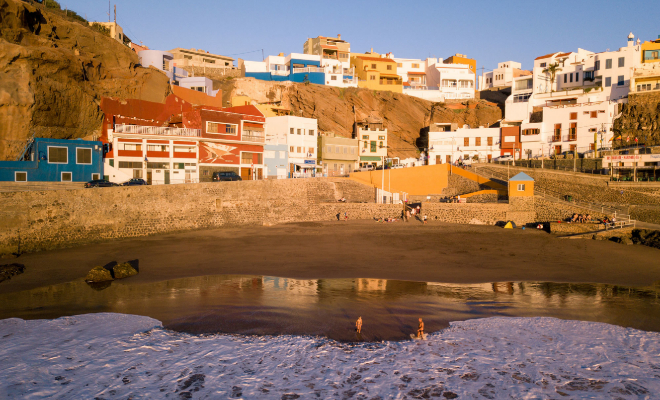Album These are the 10 most beautiful towns on the Camino de Santiago
Portugal Luxury Glamping with Europe's Largest Ship Container Pool
In the municipality of Gáldar, in the northwest of Gran Canaria, life passes at the pace set by its inhabitants. Strolling through its streets is to breathe the history of what was once the capital of the island, seat of the Guanartemes, the
aboriginal chiefs.
From the museum and archaeological park of Cueva Pintada to Calle de Capitán Quesada, known as
Calle Larga
, the commercial and vital epicenter of the historic center. And in between,
palaces in
perfect condition, squares that take visitors to another era, pedestrian streets with charming taverns.
It would be necessary to talk about the main jewel of the place, the temple of
Santiago de los Caballeros
, located in the Plaza de Santiago de Gáldar.
It is one of the largest religious buildings in the Canary Islands, with three naves and 15 chapels, where part of
the cultural legacy
related to the Apostle Santiago
is preserved
.
Not in vain, it is the Canarian point where the saint is worshiped.
Between cheese shops and wineries
Looking back, in the pre-Hispanic settlement of Agáldar, today the Royal City of
Santiago de los Caballeros de Gáldar,
Bishop Juan de Frías officiated mass, for the first time, on the Lord Santiago's day in 1482, before the end of the
conquest
of the island.
That of Agáldar would therefore be the first Jacobean dedication established outside the Peninsula, a precursor in addition to those established later in America.
Main Temple of Santiago de los Caballeros de Gáldar. CANARY ISLANDS TOURISM
On the occasion of the Jacobean Holy Year 21-22 (due to the pandemic it has been decided that it should last two years), the visit to Gáldar is more interesting than ever, since it allows you to discover the
Camino de Santiago de Gran Canaria
, unique in the world.
It is in charge of joining the south of the island, where the Jacobean church of
San Bartolomé is located,
with the Main Temple of Santiago de los Caballeros de Gáldar.
Cultural landscapes
The Way does not live by religion alone. This route also allows you to discover the
flora and fauna
of Gran Canaria, as well as the gastronomy and the historical and ethnographic heritage. "
The Camino de Santiago between volcanoes
is a State project and, therefore, a community project that encompasses all the islands", explains the general director of Tourism of the Government of the Canary Islands, Ciprián Rivas. He continues: "Of course, people will have to go through Gran Canaria because it is the place where
the two holy gates are,
that is, Tunte and Gáldar." The idea, he adds, is that the Way "backbone the territory, since around the roads there are
cheese shops, wineries
, rural tourism houses,
pilgrims' lodgings.
and hikers ...
Sardina del Norte beach in Gáldar SHUTTERSTOCK
One of the key points of the Canarian Way are the Maspalomas dunes to the south, the beginning of the 66 kilometers that await the walker.
The route continues in the
Fataga ravine,
known as the Valley of a thousand palms, and the
Arteara Necropolis
, the largest aboriginal cemetery on the island, until reaching Tunte, where the aforementioned Jacobean temple of San Bartolomé is located. .
According to oral tradition, this section of the road, from Maspalomas to Tunte, was started by some Galician sailors in the 15th century with an image of Santiago to build a hermitage in
the Heights of Tirajana
as thanks for having overcome a sea storm.
Leaving Tunte behind, the second section of the road starts at Cruz de Tejeda, where the peaks of Gran Canaria, baptized by
Miguel de Unamuno
as the "petrified storm"
, rise
.
This Unesco World Heritage cultural landscape runs through places such as the
Caldera de Tirajana
and the Gran Canaria Biosphere Reserve, which occupies 46% of the island's surface area.
View of Roque Nublo with El Teide in the background SHUTTERSTOCK
With the
Tamadaba Natural Park
as its emblem, you have to look at the Ventana del Nublo, which has the best panoramic views of the island, and walk through the pine forests of the
Llanos de la Pez
until you reach Degollada Becerra, a viewpoint with views of
Roque Bentayga and Roque Nublo
, the undisputed symbol of the island.
The final route, which joins the Cruz de Tejeda with Gáldar, descends between volcanoes,
agropastoral environments
and sacred settlements.
This is the case of the Cultural Landscape of Risco Caído and the
Sacred Mountains
of Gran Canaria, declared a Unesco World Heritage Site.
It passes through the
Caldera de los Pinos
de Gáldar until reaching the first capital of Gran Canaria, Agáldar, in its aboriginal name, the mountain town.
According to the criteria of The Trust Project
Know more
sightseeing
Canary Islands
Santiago de Compostela
Summer campaignThe extension of the summer: the sector wants to extend the season until October to wait for the British tourist
GetawaysBeach, mountain or ... farm?
The best plans in nature without leaving the Peninsula
South AfricaThe ultimate in safaris: locking tourists in transparent human cages surrounded by lions
See links of interest
Last News
Work calendar
Home THE WORLD TODAY
Master Investigation Journalism
Series
Sassuolo - Torino
Celta de Vigo - Cádiz
Newcastle United - Leeds United
Strasbourg - Metz
Wolverhampton Wanderers - Brentford

